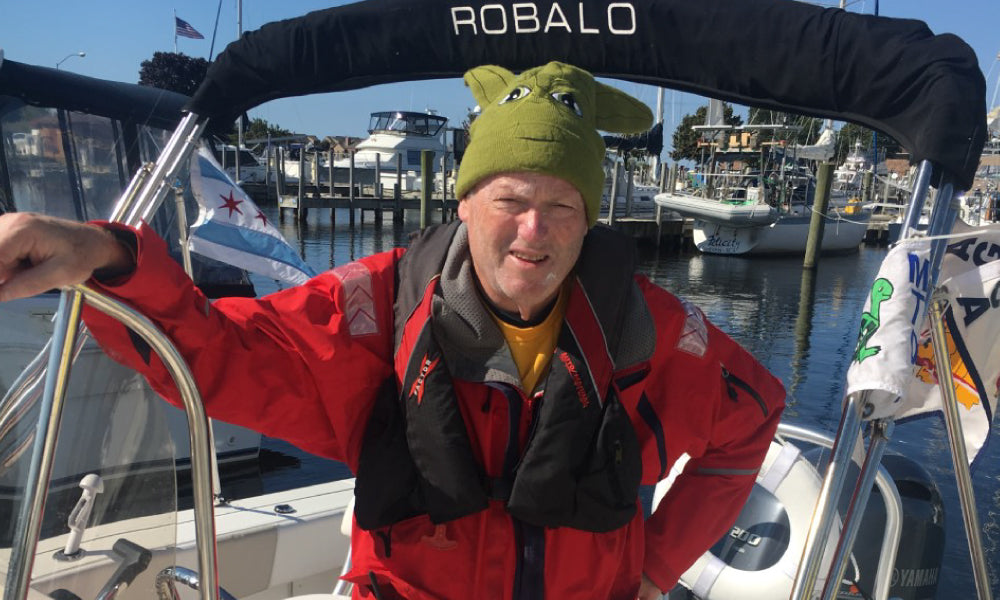PartsVu Xchange Talks Boating host Tonia Becker spoke with Mike O’Malley about the Great Loop and the tens of thousands of passionate boaters who have accomplished this journey. PartsVu Xchange Talks Boating has connected with a number of Greater Loopers, and we will be sharing these conversations with you over the upcoming weeks and months.
Mike O’Malley kicks off The Great Loop conversation in this fun and informative discussion.
Get ready for an exciting episode full of adventure and details about this fantastic adventure!
Here, we discuss the following topics:
- The geographical parameters of the route
- Different approaches for tackling The Great Loop
- Traveling alone vs. buddy boats
- Favorite parts of the journey
- Type of boat/equipment needed
- Advice for boaters interested in completing The Great Loop
Want to listen to the podcast? You can find PartsVu Xchange Talks Boating on Apple Podcasts, Spotify, Amazon Music, iHeart Radio, and Stitcher.

What is the Great Loop in boating and where does it go?
Mike: The Great Loop is a 6,000-mile waterway route that circumnavigates the eastern United States via connected rivers, lakes, canals, and coastal waters. It includes:
- Great Lakes
- Mississippi River & Ohio River
- Tombigbee Waterway
- Gulf of Mexico & Intracoastal Waterway
- Erie Canal & Hudson River
Boaters can start and end anywhere along the route, making the Great Loop a unique, once-in-a-lifetime journey for cruising enthusiasts.
What made you decide to start doing this?
Mike: I started this not knowing what the Great Loop was by accident.
My brother Jim and I bought a pontoon boat together many years ago. Jim came up with a funny idea to navigate the boat by water all the way to Miami, where another one of my brothers lived in a very upscale area, so we could show all of his high-class neighbors what a pontoon boat looks like.
Jim started the trip with a plan to go all of the way to New Orleans, where his two sons went to school. Then, the plan was for me to take the boat all of the way to Miami. However, he broke down in Cape Girardeau, Missouri, which ended our adventure.
Over the next eight years, I continued to think about taking this incredible journey on a boat. Then, as I was researching things one day on google, I came across a website called the America’s Great Loop Cruisers’ Association, which provided me with more details about how I could complete my entire adventure by water.
The nice thing about the Great Loop is that there is pretty much no way to get lost because you’re always surrounded by land. So, it’s not that difficult to run the Loop.
What are the ideal dimensions of a boat for the Loop?
Mike: Choosing the right Great Loop boat size is essential. Your boat must:
- Clear bridges as low as 19.6 feet in Chicago
- Navigate waters as shallow as 5 feet
- Fit within locks and marinas (beam under 16 feet)
Recommended dimensions for a Great Loop boat:
| Boat Specification | Recommended Limit |
| Maximum air draft (bridge clearance) | 19 feet 6 inches (for Chicago bridges) |
| Maximum draft (water depth) | 5 feet or less |
| Recommended boat length | 26 to 50 feet |
| Beam width (lock clearances) | 16 feet or less |
The Great Loop boat size varies widely, from jet skis to 40+ foot trawlers, but vessels under 50 feet are ideal for maneuverability and fuel efficiency.
You have to decide on a boat that best fits your budget. We’ve had people run the Great Loop on everything from jet skis to pontoon boats to larger luxury-style boats. The average size of a Great Loop boat is forty feet long. My boat is a twenty-foot center console with a two hundred horsepower engine.
Incidentally, I ran my Full Loop in segments because I was still working full time. But, other people complete the entire journey in one year because they’re retired or work from home.
What is the best boat size for the Great Loop?
The best boat size for the Great Loop depends on budget, comfort needs, and travel preferences.
- Smaller boats (20-30 ft) – Ideal for budget-conscious travelers who prefer speed and flexibility.
- Mid-size cruisers (35-45 ft) – Most common choice, balancing comfort, storage, and efficiency.
- Large yachts (50+ ft) – Provide luxury and space but can be challenging in shallow waters & low bridges.
Most Great Loop boaters choose a vessel between 35-45 feet, ensuring a balance of comfort, fuel efficiency, and easy maneuverability for long-distance cruising.
Does your boat have sleeping quarters?
Mike: I don’t have sleeping quarters, but I do have a portable toilet on the boat that’s never been used since I bought the boat in 2014 when I bought the boat.
We pull into a marina each night and check into a hotel or motel to sleep. We enjoy checking out the local scene and meeting people before heading off on our next trip segment.

How long is a typical segment?
Mike: It varies, but I usually take about a week off from work. We typically travel for six or seven days, find a marina with a dry stack system, and store the boat until we return for our next segment. We usually return to the marina between one and six months later to start our next leg of the journey.
Occasionally, we are limited by weather conditions, so our segments are shorter. Additionally, when rough weather is a factor, our travel distances may shorten while our travel times may stay the same.
My wife Sharon is a trooper for allowing me to do this and even accompanying me on some of the segments. She’s not a huge fan of cold or inclement weather, but it doesn’t bother me as much.
Even when the conditions aren’t ideal, boating is my nirvana. I love being behind the wheel of a boat, cruising along, enjoying the scenery, and forgetting the worries of everyday life.
Are you traveling alone or with friends when your wife isn’t available?
Mike: I enjoy traveling with my wife, but I have traveled with friends too. However, people who go need to be ready for some unexpected twists and turns. We don’t always know where we are going to sleep, how far we’re going to travel, or how we will get home, so a sense of adventure and acceptance of the unknown is essential. I’m rarely alone but willing to go by myself if needed.
Do you usually travel as a solo boat, or do you like to travel with a buddy boat?
Mike: I have only traveled with a buddy boat once because I usually cruise at a higher speed than most others. Since my boat is smaller, it can move along at about twenty-three miles per hour, whereas a forty-foot boat moves on average between six and nine miles per hour.
However, I will say that there is a lot of camaraderie in doing the Loop. People like to travel together, pull into marinas, and anchor up for dinner and other activities so buddying up is a great way to socialize after a day on the water.
What has been your favorite part of this adventure?
Mike: One of the things I’ve always wanted to do was bring my own boat into Annapolis Harbor past all of the multimillion-dollar yachts. I was lucky enough to get to fulfill that dream.
My wife and I also got to boat past the statue of liberty which was terrific. After that experience, we docked the boat, and my wife jumped on a plane to return to Chicago for work. Soon after, I received a phone call from my son John who lived in Denver and was, coincidentally, at the Newark airport. He was able to meet me and complete the three-day trip to Albany with me, which was amazing.
I also fondly remember traveling the Dismal Swamp with my son Mikey. It was spectacularly beautiful.
What advice would you give to boaters who might be interested in completing the Great Loop?
Mike: First, I recommend they dig into any information they can get their hands on. Education is key. Make sure that you know how to operate your boat safely, understand the rules of the waterways, and are proficient in boat navigation.
Second, essential safety gear for Great Loop boaters:
- Life jackets – Required by law & essential for safety.
- Marine VHF radio – For emergency communication.
- Navigation tools – Chartplotter, paper charts, and a compass.
- First aid kit – For handling minor injuries onboard.
- Anchoring gear – Reliable ground tackle for docking and safety.
Third, I highly recommend becoming familiar with “Waterway Guides.” These guides are broken down into geographical segments with details about the route and cities within the route, including marinas and more.
So, information and education are critical to your success and enjoyment.

Do you use a chartplotter for navigation?
Mike: A chartplotter wasn’t a high priority when I bought the boat. However, the dealer encouraged me to reconsider, so I bought one. I’ve got a Garmin, and it works really well to help me navigate, just like a GPS roadmap.
At night, when I’m in the hotel, I like to jump on my computer to look at Google maps for an overview of what to expect in the next part of my trip. Google maps isn’t necessarily a navigational tool, but it provides an excellent overview of what’s to come. I also use paper charts for specific segments of my trip, like the Illinois River. For more information on the Great Loop adventure, check out America’s Great Loop Cruiser’s Association. For eighty-nine dollars a year, you’ll have access to many great resources and information, including a forum for questions and answers. I also suggest that you check out Facebook, where you can find great membership groups focused on the Great Loop adventure.
Frequently Asked Questions about the Grreat Loop in boating
What is the ideal Great Loop boat size for comfort and efficiency?
The ideal Great Loop boat is typically between 34 and 45 feet long. This range offers a comfortable onboard living experience while remaining small enough to navigate tight marinas, canals, and low-clearance bridges. Boats in this size range often feature sleeping quarters, a galley, and ample storage, making them efficient for long-term cruising without compromising on maneuverability or fuel economy. Choosing a boat with a draft under 5 feet and an air draft under 19 feet is also crucial for accessing all segments of the loop without detours.
What bridges on the Great Loop have the lowest clearance?
The Chicago Sanitary and Ship Canal contains the lowest fixed bridge on the Great Loop, with a clearance of approximately 19.6 feet. This bridge is often considered the benchmark for determining your vessel’s air draft. To avoid rerouting, most Loopers choose boats that can pass beneath this structure. While there are movable bridges throughout the route, this fixed bridge is a critical consideration when planning your vessel size and any removable masts, antennas, or radar arches.
How long does it take to complete the Great Loop?
Most boaters complete the Great Loop in 9 to 12 months, depending on weather, personal pace, and side trips. Some choose to complete it in sections over multiple years, while others follow seasonal patterns—traveling north in the spring and south in the fall. Factors like cruising speed, sightseeing preferences, and time spent in each harbor greatly affect the overall timeline. Many Loopers average around 50 miles per day, taking time to enjoy key destinations along the way.












